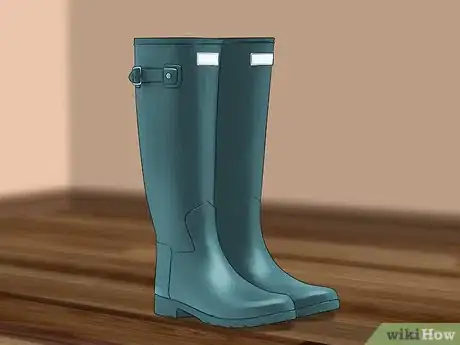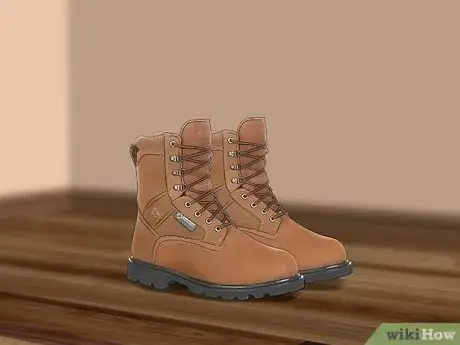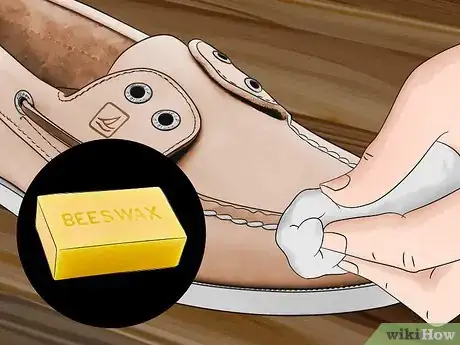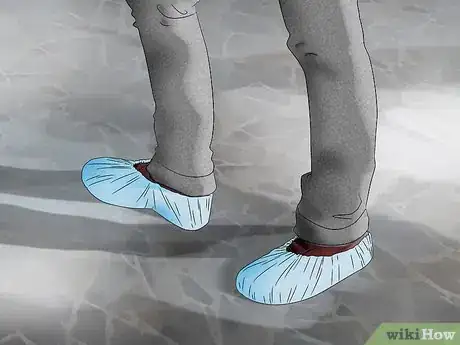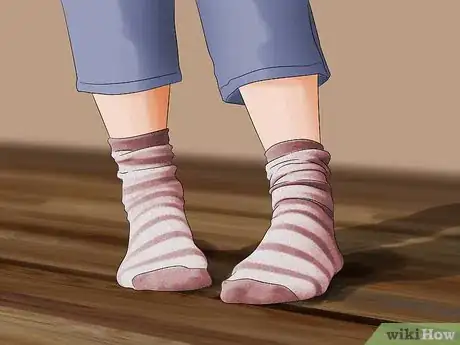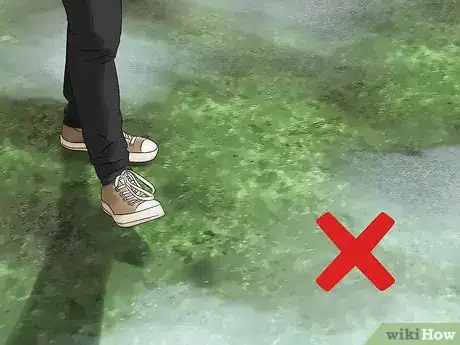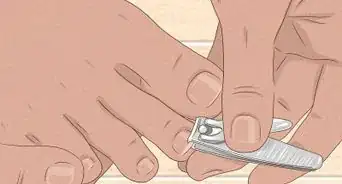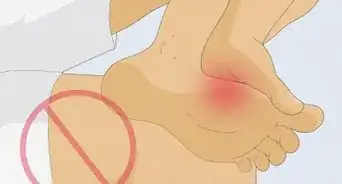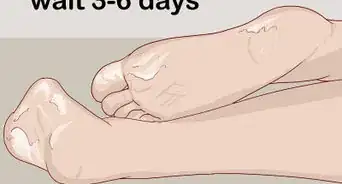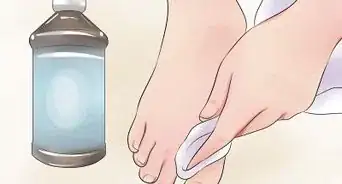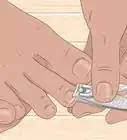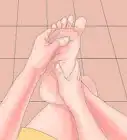This article was co-authored by Miguel Cunha, DPM. Dr. Miguel Cunha is the founder of Gotham Footcare and is a podiatrist based in Manhattan, New York. Dr. Cunha is a foot and ankle surgeon with experience treating a wide array of foot and ankle conditions from minor problems to complex reconstructive foot and ankle surgery. Dr. Cunha received his DPM from the Temple University School of Podiatric Medicine and completed his residency as the Chief Resident at the Washington Hospital Center and Georgetown University where he specialized in lower extremity trauma, diabetic limb salvage, and reconstructive surgery of the foot and ankle. Dr. Cunha is a member of the American Podiatric Medical Association, the New York Podiatric Medical Association, the American College of Foot and Ankle Surgeons, and is board certified in Podiatric Medicine.
There are 11 references cited in this article, which can be found at the bottom of the page.
This article has been viewed 61,279 times.
If the fear of soggy socks is enough to keep you confined to your home during a stiff downpour, it may be time to invest in some footwear that's appropriate for wet weather. Materials like leather and Gore Tex provide excellent water resistance, or you could try waterproofing an old pair of sneakers using a repellent wax or oil. And, of course, you'll want to keep your distance from puddles, heavy streams, and other wet spots that could leave you with wrinkly toes.
Steps
Upgrading Your Footwear
-
1Pull on a pair of rain boots. Rain boots are designed specifically for this purpose, so it's no wonder they work so well. The thick rubber material used to make them is completely impervious to water, and will keep your feet and lower legs dry up to about shin-height, or even higher, if you go with a knee-length model.[1]
- You can even find lined and insulated rain boots for protection from winter storms and treks through wet, cold conditions.
- If you're going to be making your way through several feet of standing water, consider purchasing a pair of waders, which are essentially extra-tall rain boots.
-
2Switch to shoes that are made from water-resistant materials. Synthetic fabrics like nylon and Gore-Tex are tough for moisture to saturate, making them ideal for mild inclement weather. Leather is another material with natural water-resistant properties. Full-grain leather has stood the test of torrential rains for centuries.[2]
- Be sure to grab a pair with a solid, one-piece construction, as water can still seep through woven fabrics when submerged or exposed to a heavy downpour.
- Keep an eye out for water-resistant products from your favorite brands. Nowadays, more and more companies are offering water-resistant versions of classic styles.
Advertisement -
3Waterproof your shoes yourself. Assuming you don't want to drop a bundle on a new pair of shoes or boots, you have the option of re-outfitting an old pair. Treating leather and textile footwear with a quality oil or silicone spray will instantly make them more wet-weather worthy. If your go-to kicks are canvas, rub them down with an even coat of all-natural beeswax.[3]
- It may be necessary to reapply your waterproofing agent of choice periodically, depending on how frequently you go stomping around in soupy settings.
- The oily molecules in most oils, waxes, and sprays actually block and repel water, keeping it from coming into contact with the vulnerable material underneath.
- You can typically find waterproofing products at shoe stores and outdoor supply shops. If you're not having any luck, try purchasing them online.
-
4Invest in some quality shoe covers. Shoe covers slip right over the shoes you're wearing and cinch snugly to the ankle to provide a top-to-bottom buffer against rain and standing water. The biggest advantage of shoe covers is that you can wear whatever you want on your feet without worrying about them getting wet, rather than having the weather dictate your choice of footwear for the day.[4]
- Shoe covers are available at most major shoe stores, as well as outdoor retailers in the rain gear section. They can often be purchased for as little as $10.
- If your feet are on the small side, a shower cap could double as a makeshift shoe cover in a pinch.[5]
-
5Wear wool socks. Ditch your ordinary cotton socks and trade them in for a pair spun from merino wool. Wool is naturally lightweight, breathable, and moisture-wicking, so your feet will dry much faster even if you do happen to get drenched. For this reason, they're an excellent companion for water-resistant or waterproofed footwear.[6]
- Wool socks will even make sweaty feet less of an issue when it's not raining cats and dogs.
- Best of all, wool can be worn year-round—the material's superior ventilation means your feet won't get as hot in the warm spring and summer months.[7]
-
6Cover your feet with plastic bags. When you've got no other options available, a little ingenuity can spare you the discomfort of walking around with cold, wet feet all day. Slip into a pair of clean, dry socks (preferably wool), then bundle a plastic shopping bag or wastebasket liner around each foot.[8] Smooth out the excess material and secure the plastic around your ankles using tape.[9]
- Fit your fortified feet into your shoes, making sure there's as little plastic showing as possible, or pull a second pair of socks on over the bags for maximum protection against the elements.
- This trick works well with ordinary sneakers and boots, but may not be as successful when attempted with slip-ons, heels, dress shoes, or similar styles.
- Since your shoes will get wet if you do this, be sure to air-dry them as soon as you come back indoors, and make sure they're completely dry before you wear them again. For instance, you might place your shoes near an air vent, since the air circulation will dry them faster.[10]
- After your shoes are dry, spray them with a disinfecting spray to kill any bacteria, fungus, or other organisms that could cause foot odor or a fungal infection.[11]
Finding Other Ways to Stay Dry
-
1Avoid walking in areas where rainwater has collected. Tread carefully and scan the ground with your eyes as you go. Take an alternate route, if need be. Since your goal is to keep your feet from inadvertently becoming sponges, the last thing you want to do is sink ankle-deep into a puddle because you aren't looking where you're going.
- Overhangs, underpasses, and gutters are other places where water tends to flow freely following a heavy rain.
- If you have no choice but to step through a puddle or stream, do it on tiptoe to keep the parts of your shoes that are most easily infiltrated out of the water.
-
2Run to escape sudden showers. When it begins pouring unexpectedly, head for a dry, covered spot on the double. The faster you move, the fewer raindrops you'll be exposed to and the sooner you'll make it to a place where you can wait out the worst of the storm.[12]
- Watch your step. The surface you're running on is likely to become slick once it gets wet.
- Tree branches, extended ledges, and other natural and man-made objects can provide a little helpful cover until you reach a better shelter.
-
3Have a friend drive you around. Call up your most dependable pal and ask them if they would mind giving you a ride to run some quick errands. They'll be able to drop you off and pick you up right at the entrance, minimizing the amount of time you spend sloshing through rain-soaked parking lots and city streets.
- Offer to pay your friend back by treating them to lunch or putting up a few dollars for fuel.
-
4Bring along an extra pair of socks. If you've taken every possible precaution and still ended up with wet feet, never fear. Simply throw a second pair of socks into your purse, backpack, or gym bag to serve as a backup. You'll be glad you did in the event that you actually have to use them![13]
- Be sure to leave your spare socks where they won't get wet. A glove box or locker is a more secure location for them than inside one of your jacket pockets.
Expert Q&A
-
QuestionIf I'm going to be walking outside in heavy rain, how can I keep my feet dry?
 Miguel Cunha, DPMDr. Miguel Cunha is the founder of Gotham Footcare and is a podiatrist based in Manhattan, New York. Dr. Cunha is a foot and ankle surgeon with experience treating a wide array of foot and ankle conditions from minor problems to complex reconstructive foot and ankle surgery. Dr. Cunha received his DPM from the Temple University School of Podiatric Medicine and completed his residency as the Chief Resident at the Washington Hospital Center and Georgetown University where he specialized in lower extremity trauma, diabetic limb salvage, and reconstructive surgery of the foot and ankle. Dr. Cunha is a member of the American Podiatric Medical Association, the New York Podiatric Medical Association, the American College of Foot and Ankle Surgeons, and is board certified in Podiatric Medicine.
Miguel Cunha, DPMDr. Miguel Cunha is the founder of Gotham Footcare and is a podiatrist based in Manhattan, New York. Dr. Cunha is a foot and ankle surgeon with experience treating a wide array of foot and ankle conditions from minor problems to complex reconstructive foot and ankle surgery. Dr. Cunha received his DPM from the Temple University School of Podiatric Medicine and completed his residency as the Chief Resident at the Washington Hospital Center and Georgetown University where he specialized in lower extremity trauma, diabetic limb salvage, and reconstructive surgery of the foot and ankle. Dr. Cunha is a member of the American Podiatric Medical Association, the New York Podiatric Medical Association, the American College of Foot and Ankle Surgeons, and is board certified in Podiatric Medicine.
Board Certified Podiatrist Rain boots are going to work best, but if you don't have a pair, wrap your feet in a plastic bag before you put your shoes on. However, keep in mind that your shoes will still get wet, so be sure to dry them completely before you wear them again.
Rain boots are going to work best, but if you don't have a pair, wrap your feet in a plastic bag before you put your shoes on. However, keep in mind that your shoes will still get wet, so be sure to dry them completely before you wear them again.
Warnings
- Not only are wet feet uncomfortable, but they can actually lead to serious health risks like fungal infections, trench foot, and leptospirosis if they stay damp for too long.⧼thumbs_response⧽
Things You'll Need
- Rain boots
- Water-resistant footwear
- Waterproofing agent
- Shoe covers
- Wool socks
- Plastic bags
References
- ↑ https://www.outdoorgearlab.com/topics/shoes-and-boots/best-rain-boots/buying-advice
- ↑ http://comfortworkboots.com/what-waterproof-materials-are-used-in-footwear/
- ↑ https://www.shoezone.com/Blog/how-to-waterproof-boots-shoes-your-complete-guide
- ↑ https://mic.com/articles/181627/these-shoe-covers-will-keep-your-feet-dry-come-rain-or-torrential-downpour#.5iaPHU2Uk
- ↑ https://www.verywellfit.com/waterproof-shower-cap-shoe-3436854
- ↑ https://backpackinglight.com/wet-cold-feet-when-backpacking-gear/
- ↑ https://www.ems.com/f/ea-how-to-choose-summer-hiking-socks.html
- ↑ Miguel Cunha, DPM. Board Certified Podiatrist. Expert Interview. 22 April 2020.
- ↑ https://blog.the3day.org/2014/08/13/3-day-wet-weather-walking-advice/
- ↑ Miguel Cunha, DPM. Board Certified Podiatrist. Expert Interview. 22 April 2020.
- ↑ Miguel Cunha, DPM. Board Certified Podiatrist. Expert Interview. 22 April 2020.
- ↑ http://www.bbc.com/news/science-environment-18901072
- ↑ http://www.businessinsider.com/11-rainy-day-hacks-2014-4
